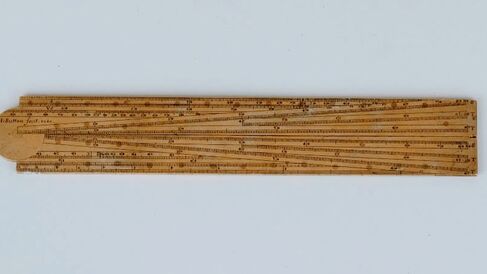The Sector

The rise of instrumentation in medieval natural philosophy was intimately bound to the study of the heavens. However, the revival of geometry also served practical aims, in construction and in war. A new instrument, the sector, allowed for calculations to be made based on the proportions between triangles.
This slide was used in a lecture by Michael Faraday (1791-1867), to illustrate his work on colloids (mixtures of two substances). Faraday would have shown the slide by using a projecting microscope. This pre-prepared experiment was typical of Faraday's lectures, which became famous and were attended by Prince Albert, among other wealthy and famous members of Victorian society.
The micrometer is an accessory for the microscope that allows measurements to be taken of minute objects. One early method of measuring through a microscope involved placing a fine lattice of silver wires between the microscope's lenses. 'Micrometry' is the technique of using micrometers, though the term was only coined in the 19th century. In the 18th century, however, there was considerable debate about the importance of microscopic measurement, and also how it was to be achieved. Here the debate is illustrated by a pamphlet from the late 18th century.
The first convenient micrometer
"I have always judged a Microscope extremely imperfect and defective without a Micrometer" (1)
This statement by Benjamin Martin, though made in a pamphlet (circa 1775) promoting his own design of micrometer, may be taken seriously as his view on the correct use of a microscope. It was Martin who had, in 1732, resolved the problem of convenient measurement with a microscope. The variety of attempts before that date illustrate both the difficulty of and need for an accurate method of assessing the size of microscopic phenomena.
The stars and the land
Astrolabes and quadrants were instruments first devised in antiquity and developed in the Middle Ages to chart the movements of stars, and they also became very useful tools for surveying.
One could use sightlines and angles to calculate unknown distances from known ones, as seen in this depiction of a surveying problem from a book by Leonard Digges (c. 1515-c. 1559) (Image 1). Digges is also credited with inventing the theodolite, a specialist surveying tool that used a refracting lens to help calculate angles.
Though helpful for observation, tools such as the astrolabe, quadrant, and theodolite required their user to have a good knowledge of arithmetic. Only a select few had the ability to carry out complex calculations, and especially in the context of war, it became clear that a tool dedicated to calculations was needed.
Reading the book of nature
Little known at the time, Galileo Galilei (1564-1642) was a lecturer at the University of Padua, where he taught courses on practical subjects such as military architecture. During this time, behind closed doors, he set an instrument maker to work on a device based on the proportional compass, a drawing tool, to aid in artillery calculations.
Galileo was probably not the first to 'invent' such a device, which became known as a sector. He may have gotten the idea from a friend, and London mathematician Thomas Hood was already familiar with a version of the instrument at the time. However, Galileo's writings did much to publicize the device. He became known for his view of mathematics as the core of natural philosophy, which was novel in the strength of his insistence:
"[The book of nature] is written in the language of mathematics, and its characters are triangles, circles, and other geometric figures without which it is humanly impossible to understand a single word of it; without these, one wanders about in a dark labyrinth." Galileo Galilei, Il Saggiatore, 1626 (1)
We might say that Galileo saw the sector as a way to become better acquainted with nature through simplified calculations.
Sectors had different sets of rulings for different types of calculations, identical on each arm. A pair of dividers was used to match points along the rulings, and it could also be used as a protractor to measure angles. Some sectors even included a clamp, to suit their role as an artillery compass.
While it might seem to us like only a ruler, its design was revolutionary in that it portrayed measurement lines alongside 'artificial lines': sines, tangents, and logarithms. Combined with knowledge of proportions between triangles, the sector was a powerful instrument.
A classic sector
One of the Whipple Museum's sectors, made by the instrument maker Henry Sutton, is based on a design by the famous mathematician Edmund Gunter(Image 2 and above). Gunter was the first to design instruments using logarithms. His sector contained a number of useful scales for geometry and navigation, including ones for determining the date.
Read more
References
- Quoted in: S. Drake, Discoveries and opinions of Galileo (New York: Doubleday & Company, 1957), pp. 237-238.
Mikey McGovern
Mikey McGovern, 'The Sector', Explore Whipple Collections, Whipple Museum of the History of Science, University of Cambridge
